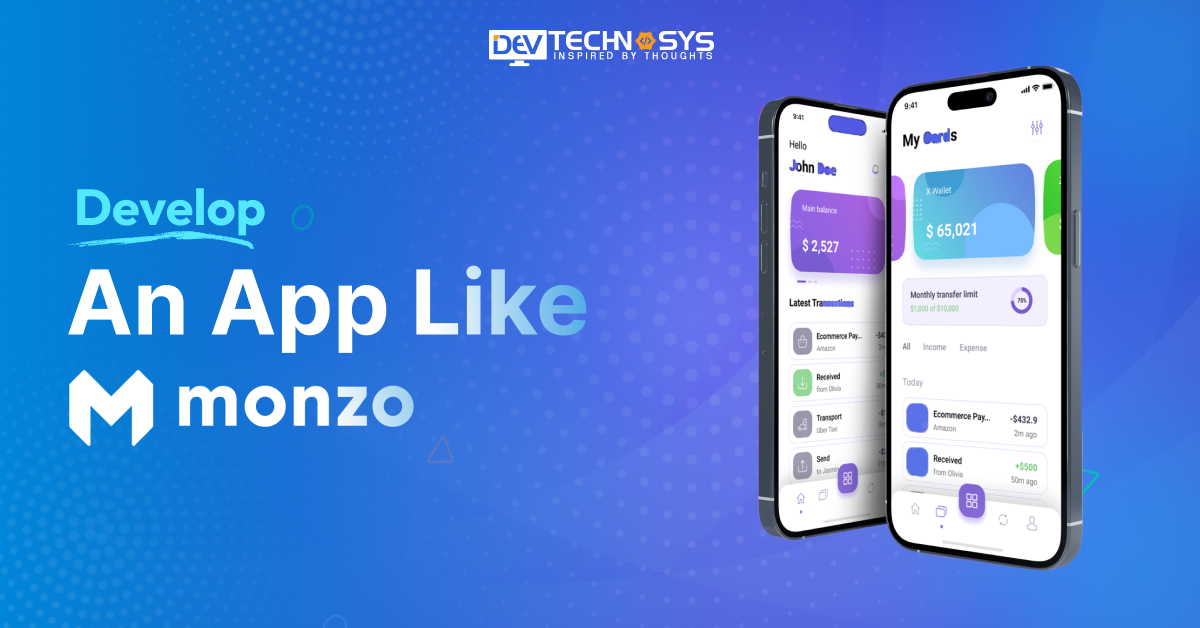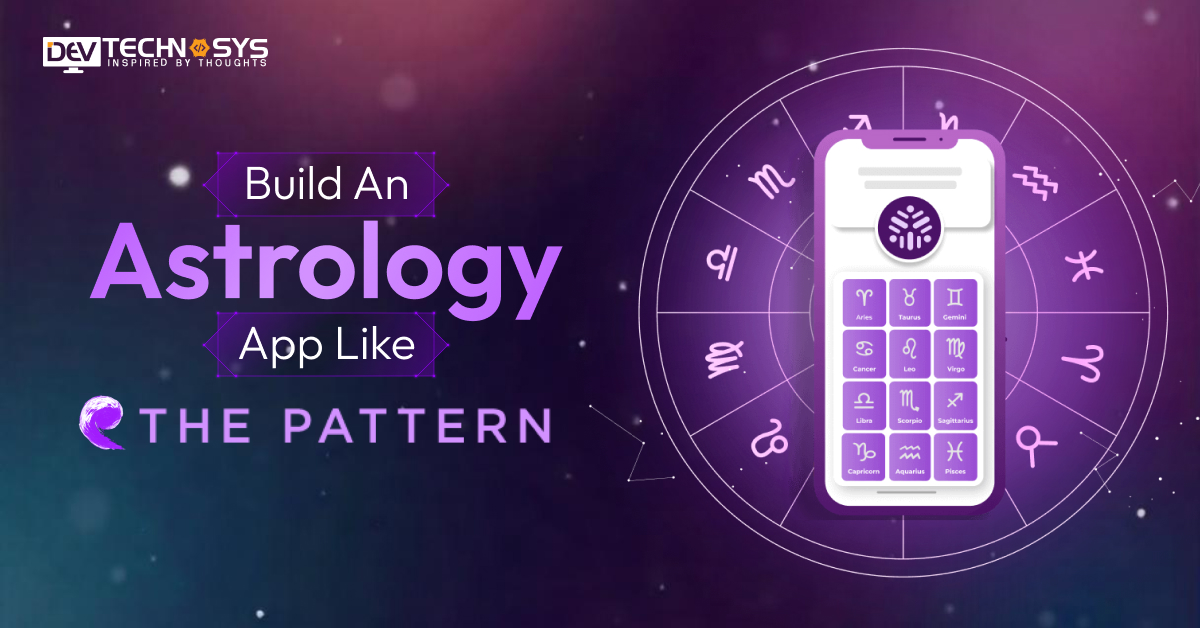“Tap, Pay, Relax”
Technology is growing rapidly, and people are not missing out on using technology; they are also keeping pace with the new world. Talking about the finance sector, nowadays you do not need to stand in a long queue to transfer money from one account to another, just open the banking app on your mobile phone and send money with just a tap.
Welcome to a banking app like Monzo, which enables users to transfer huge amounts of money within seconds and use advanced banking features to manage finances in real-time.
As per the recent survey, the global banking applications market was valued at around $1.34 billion in 2024. It is expected to increase to around $4.26 billion by the end of 2032.
The above figures show that investing in banking application development is a massive opportunity for entrepreneurs to expand their business to the next level.
In this blog, we provide detailed information about how to develop an app like Monzo, features, cost, money-making strategies, and many more.
Keep Connected!
What is Monzo App?
Monzo is a mobile-only, UK-based digital bank dedicated to making money management simple and transparent. It includes features such as quick spending notifications, smart budgeting tools, savings accounts, and fee-free international shopping.
Apps like Revolut or Monzo allow users to rapidly freeze or unfreeze their cards, obtain real-time analytics, and get 24-hour customer service. Monzo’s slick software and straightforward design give you ultimate control over your funds.
- Instant account setup
- Monthly budget setting
- Biometric login (Face ID, Touch ID)
Market Analysis of Mobile Banking Applications
- In 2024, the global market for banking apps was estimated to be worth $1.34 By the end of 2032, it is anticipated to rise to almost $4.26 billion.
- The global market is anticipated to expand at a compound annual growth rate (CAGR) of 60% from 2024 to 2032.
- According to a study, North America holds the largest revenue of mobile banking applications, and it is expected to increase during the forecast period.
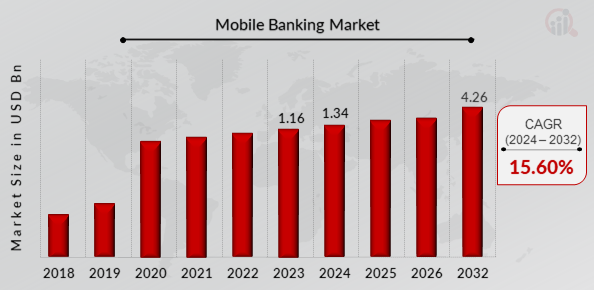
- With a 5% market share in 2023, the Asia Pacific region led the digital banking platform market.
- Rising demand for smart mobile devices, the transition from conventional to digital channels, and a surge in applications for machine learning (ML) and artificial intelligence (AI) are the main reasons propelling the market for digital banking platforms.
Top 10 Banking Applications Like Monzo
Discover the top 10 digital banking apps like Monzo, offering smart money management, real-time spending insights, seamless payments, and modern financial tools, all in one place.
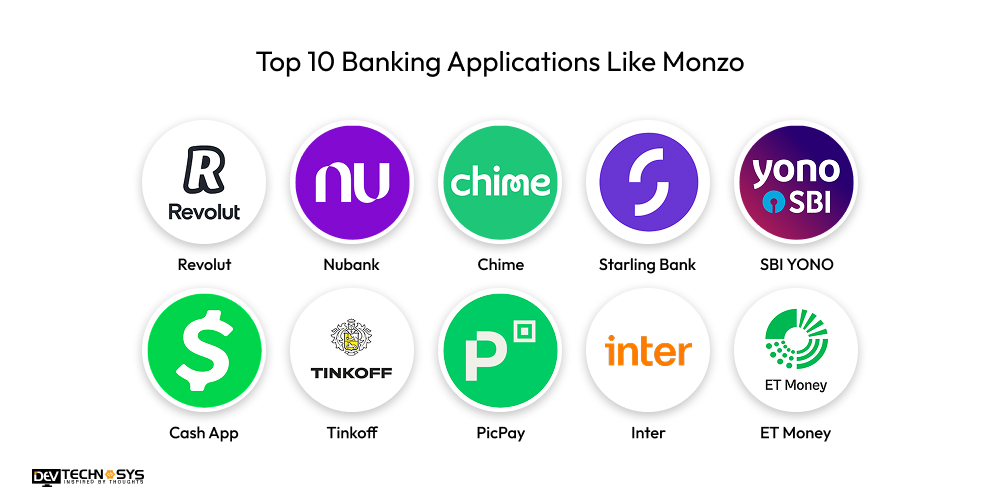
App Name |
Downloads |
Stores Ratings |
Launch Year |
Platform Availability |
| Revolut | 21M+ | 4.7 | 2015 | iOS, Android |
| Nubank | 50M+ | 4.8 | 2013 | iOS, Android |
| Chime | 14M+ | 4.6 | 2014 | iOS, Android |
| Starling Bank | 2M+ | 4.7 | 2014 | iOS, Android |
| SBI YONO | 50M+ | 3.9 | 2017 | iOS, Android |
| Cash App | 57M+ | 4.6 | 2013 | iOS, Android |
| Tinkoff | 16M+ | 4.8 | 2006 | iOS, Android |
| PicPay | 20M+ | 4.6 | 2012 | iOS, Android |
| Inter | 15M+ | 4.7 | 2015 | iOS, Android |
| ET Money | 5M+ | 4.3 | 2015 | iOS, Android |
Why Businesses Invest in Mobile Banking App Development?
In today’s fast-paced digital economy, mobile banking is no longer a luxury—it’s a requirement. Businesses in the financial and technology industries are spending extensively on mobile banking app development to remain competitive and satisfy changing client expectations. There are five strong reasons why:
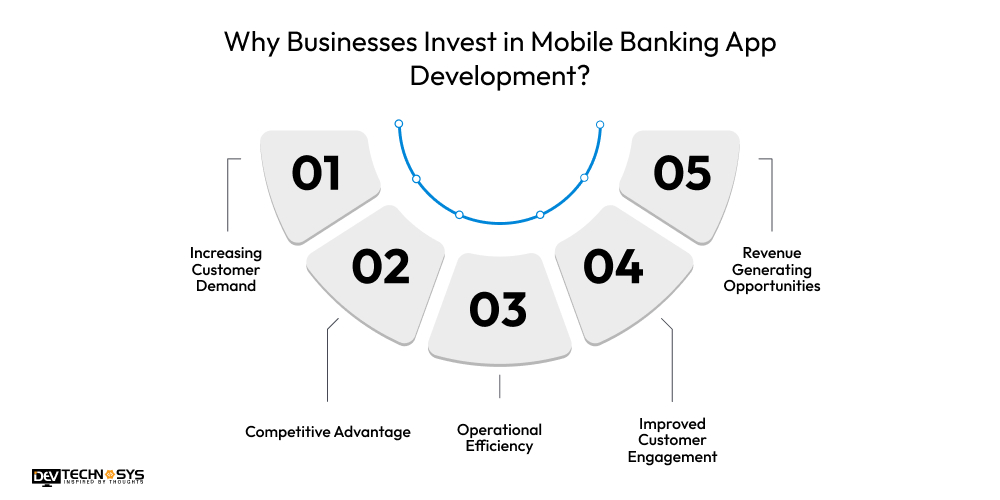
1. Increasing Customer Demand
Customers demand banking at their fingertips. As smartphones become the dominant form of internet access, individuals choose mobile applications for everything from checking accounts to making fast transactions. Businesses are reacting to this need by developing intuitive, feature-rich applications that provide ease and real-time financial management.
2. Competitive Advantage
A well-designed Monzo bank app may help a company stand out. Real-time notifications, rapid card locking, spending analytics, and an easy-to-use interface all improve the consumer experience. Apps similar to Monzo, Revolut, and Chime have used mobile-first tactics to threaten traditional banks and attract younger, tech-savvy customers.
3. Operational Efficiency
The banking app development solutions automate a variety of traditional activities, including customer care, KYC, and transaction processing. This lowers the need for physical infrastructure and manual intervention, lowering costs and increasing efficiency. Businesses can service more clients with fewer resources, which improves scalability and profitability.
4. Improved Customer Engagement
Push alerts, tailored analytics, in-app messaging, and loyalty schemes keep users interested. As we discussed earlier with the Monzo app development company, mobile applications provide constant consumer touchpoints, allowing businesses to create connections, enhance engagement, and collect vital behavioral data for future personalization.
5. Revenue Generating Opportunities
The fintech app development solutions provide additional income sources through premium features, subscription models, loan services, and affiliate relationships. Integrated financial services, cross-selling insurance, and investment possibilities within the app offer further development opportunities.
How AI Can Help Banking Applications Like Monzo?
- AI analyzes spending patterns to provide personalized budgeting advice and financial insights, helping users manage money smartly daily.
- Chatbots powered by AI offer instant, 24/7 customer support, resolving queries quickly without needing human intervention, enhancing the user experience.
- AI development detects fraudulent transactions in real-time by analyzing behavior anomalies, protecting users from unauthorized access and financial loss.
- Automated loan and credit risk assessments use AI algorithms, speeding up approval processes while minimizing errors and bias.
- AI-driven predictive analytics forecast cash flow needs and recommend savings strategies, empowering users to reach financial goals efficiently.
7 Steps to Develop an App Like Monzo
Developing an app like Monzo means creating a secure, user-friendly digital banking platform with real-time spending insights, smart budgeting tools, instant payments, and compliance with financial regulations. So, here we provide the mobile wallet app development process:
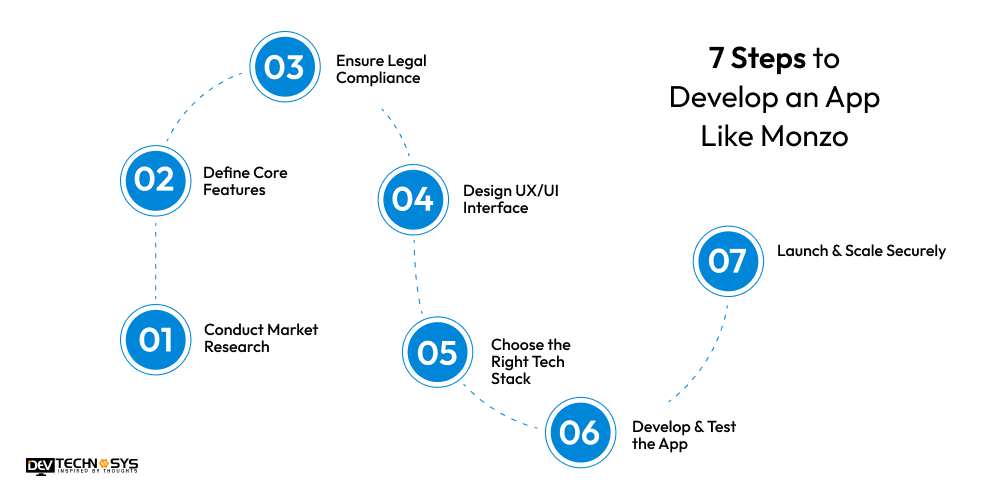
1. Conduct Market Research
Start by analyzing the digital banking market, competitors like Monzo, and user expectations. Identify gaps, compliance requirements, and trends. Hire mobile app developers to gather insights into customer pain points, features in demand, and regulatory frameworks. This foundation helps define a strong value proposition and guides your product roadmap before investing in design or development.
2. Define Core Features
List essential features: account creation, instant transactions, spending insights, card controls, savings pots, and security tools. Include must-haves like biometric login, in-app chat support, and real-time notifications. Prioritize MVP features to validate your idea quickly while planning scalable infrastructure for future upgrades and banking functionalities.
3. Ensure Legal Compliance
Hire a professional mobile app development company to understand financial regulations in your target market—such as PSD2 (Europe), GDPR, and FCA licenses (UK). Partner with legal advisors to obtain necessary banking licenses, ensure data protection, implement KYC/AML policies, and build trust. Compliance is crucial to operate legally and protect users’ data, funds, and privacy from day one.
4. Design UX/UI Interface
Create an intuitive, minimalist, and mobile-first user interface. Focus on easy navigation, clear financial visualizations, and delightful micro-interactions. Design wireframes, then build clickable prototypes to validate with users. Accessibility, speed, and consistency across devices enhance user trust and satisfaction. A clean design mirrors the transparency your brand represents.
5. Choose the Right Tech Stack
Let’s move to the fifth stage of mobile banking application development, select scalable and secure technologies: React Native or Flutter for mobile apps, Node.js or Python for backend, and PostgreSQL for databases. Use APIs for payments, identity verification, and integrations (e.g., Plaid). Build with cloud platforms like AWS or Azure to ensure reliability, uptime, and data encryption compliance.
6. Develop & Test the App
Start with the MVP—core banking, authentication, and transaction features. Use Agile methodology for iterative development. Continuously test for security, usability, and performance across devices. Conduct thorough QA, including penetration testing and UAT. Gather feedback, fix bugs, and refine. Ensure all systems are stable before public launch.
7. Launch & Scale Securely
In the last stage of banking app development, soft-launch to a limited user base, collect usage data, and iterate fast. Scale gradually with robust customer support. Launch marketing campaigns and referral programs. Continue compliance audits and implement user-requested features. Invest in user education, proactive support, and performance monitoring to ensure long-term engagement, trust, and app stability.
10 Must-Have Features of a Banking Application Like Monzo
Creating a successful bank similar to Monzo requires a combination of security, usability, and innovative features that put users in control of their finances. Here are ten essential features every banking app like Monzo must include:
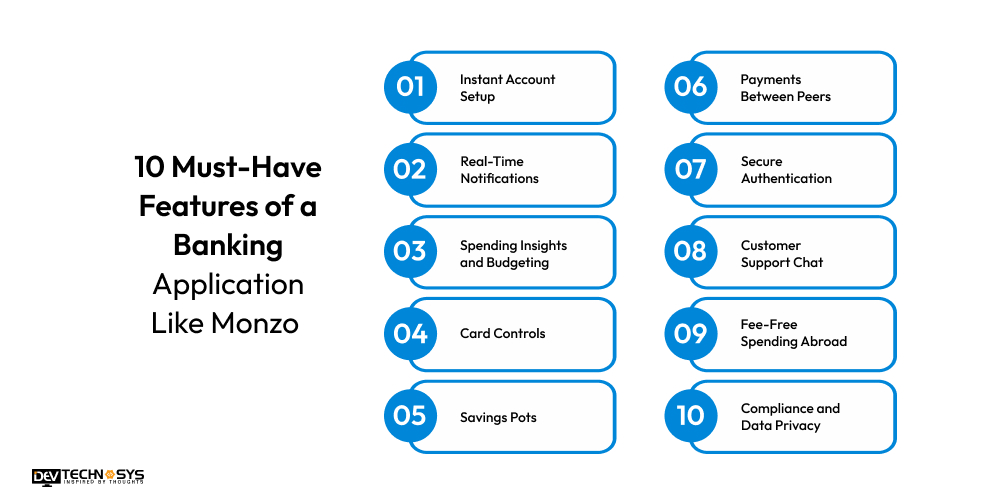
1. Instant Account Setup
Monzo alternatives allow users to anticipate quick and simple onboarding with minimum paperwork, allowing them to establish accounts in minutes via mobile.
2. Real-Time Notifications
The Monzo cash app offers push alerts for each transaction, enabling customers to track spending instantly, spot fraud early, and stay updated about their account activities.
3. Spending Insights and Budgeting
Automatic expenditure categorization, visual graphs, and monthly budgets enable customers to manage their money more effectively and minimize overspending.
4. Card Controls
The Monzo clone app offers features such as quick card freezing, spending restriction settings, and virtual card creation to improve security and user spending management.
5. Savings Pots
Separate “pots” or sub-accounts empower users to effortlessly save for their objectives, with possibilities for round-ups and scheduled transfers.
6. Payments Between Peers
Seamless, quick transfers to friends and family via phone contacts or app connections improve convenience and social connection.
7. Secure Authentication
Biometric login (Face ID, fingerprint) paired with multi-factor authentication offers the greatest level of security. To integrate this feature in your app, connect to an e-wallet app development company.
8. Customer Support Chat
Monzo alternatives provides quick help and builds trust by offering real-time assistance without needing phone calls.
9. Fee-Free Spending Abroad
Competitive foreign exchange rates and no hidden fees make the app ideal for travelers and international transactions.
10. Compliance and Data Privacy
The Monzo clone app offer strict adherence to financial regulations, data encryption, and transparent privacy policies protect user information and builds confidence.
What is the Cost to Develop an App Like Monzo?
The cost to build an app like Monzo varies greatly depending on features, complexity, and area. Basic banking apps typically cost between $8,000 and $16,000 for MVP versions that include key services such as account registration, transactions, and alerts.
More sophisticated features—real-time analytics, AI-powered insights, security layers, and integrations—can cost $25,000 or more. Ongoing costs include compliance, maintenance, and upgrades. Choosing skilled developers and scalable technology is critical to long-term success and cost-effectiveness.
Banking App Development
|
Estimated Cost |
Time Frame |
Normal App Development
|
$8000 – $12000 | 2 to 6 Months |
Mid-Complex App Development
|
$14000 – $19000 | 6 to 8 Months |
High-Complex App Development
|
$25000+ | 9+ Months |
5 Major Factors that Affect the Banking Application Development Cost
Several key factors influence the cost to develop an app like Monzo, including app complexity, number of features, security requirements, platform choice (iOS, Android, or both), design quality, regulatory compliance needs, and developer location. Each element impacts time, resources, and budget, ultimately shaping the overall investment in NFC payment app development.
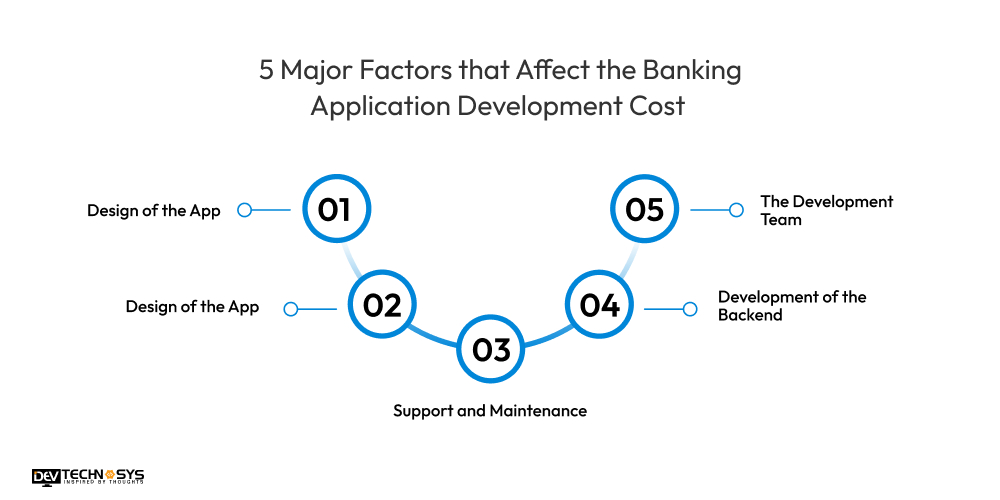
1. Design of the App
A well-crafted UI/UX design increases user engagement and trust. Custom, intuitive designs with nice animations are more expensive than standard templates. The complexity of displays, interactions, branding components, and responsiveness across devices has a direct impact on design time and mobile banking app development cost.
Design Quality |
Cost Estimation |
| Basic Design | $8,000 – $12,000 |
| Complex Design | $15,000 – $22,000 |
2. Simple vs Premium Features
Basic features like transactions and balance checks are less expensive, but premium tools like AI-driven insights, biometric security, and multi-currency compatibility need sophisticated development. Each extra feature requires more time, testing, and resources. Choosing between a basic MVP and a full-featured software has a substantial influence on total Monzo app development cost and future scaling plans.
Basic Features |
Estimated Cost |
Advanced Features |
Estimated Cost |
| User registration & login | $6,000 – $9,000 | AI-powered spending insights | $4,000 – $7,000 |
| Account balance display | $4,000 – $7,000 | Real-time fraud detection | $3,000 – $5,000 |
| Transaction history | $8,000 – $12,000 | Biometric authentication | $10,000 – $14,000 |
| Money transfers | $7,000 – $11,000 | Multi-currency wallets | $7,000 – $10,000 |
| Basic budgeting tool | $10,000 – $12,000 | Credit score tracking | $10,000 – $15,000 |
3. Support and Maintenance
The Monzo mobile app maintenance services include bug fixes, updates, server monitoring, and security patches. Ongoing maintenance guarantees the app’s reliability and customer satisfaction. These recurrent expenditures, which are typically 15-20% of the original budget every year, are required to maintain the app functioning, safe, and competitive in response to user feedback and regulatory changes.
Service Level |
Description |
Estimated Annual Cost (USD) |
Estimated Time |
| Basic Support | Bug fixes, minor updates | $3,000 – $6,000 | Ongoing |
| Comprehensive Support | Frequent updates, performance optimization | $6,000 – $9,000 | Ongoing |
4. Development of the Backend
Backend infrastructure drives all user actions, including login, payments, alerts, and data storage. Building a safe, scalable, and compliant backend using APIs, encryption, and cloud integration necessitates specific skills. Backend systems that are more robust and configurable take longer and raise Monzo app development cost, especially when it comes to providing real-time performance and regulatory data protection standards.
Backend Complexity |
Estimated Cost (USD) |
Estimated Time |
| Basic Backend | $5,000 – $10,000 | 3 – 6 weeks |
| Advanced Backend | $10,000 – $18,000 | 6 – 10 weeks |
5. The Development Team
The location, experience, and structure of the team all have a significant impact on expenses. Hiring an in-house staff, freelancers, or outsourcing to agencies results in differing price structures. Developers in North America and Europe charge more than those in Asia. Senior-level personnel may be more cost to fintech app development, but it assures higher quality, faster delivery, and scalable architectural decisions.
Developers Experience level |
United States |
United Kingdom |
Southeast Asia |
Eastern Europe |
| Junior-level | $15 – $25 | £14 – £24 | $12 – $22 | $10 – $20 |
| Mid-level | $30 – $50 | £27 – £44 | $25 – $35 | $25 – $33 |
| Senior-level | $60 – $80 | £50 – £65 | $40 – $55 | $40 – $50 |
5 Money-Making Techniques of a Banking Application like Monzo
While banking apps like Monzo provide free, user-friendly services, they also deploy sophisticated monetization tactics to assure long-term profitability and sustainability. Here are five important ways that these apps earn cash.
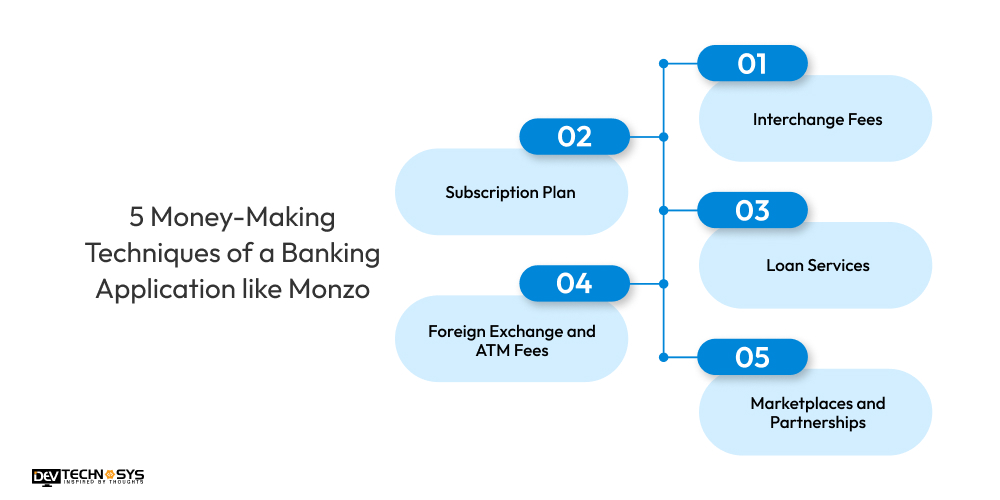
1. Interchange Fees
Every time a user pays with their Monzo card, the retailer pays a tiny interchange charge. A percentage of this cost is paid to the card’s issuing bank—in this example, Monzo. With an increasing user base making regular card payments, this becomes a reliable source of cash.
2. Subscription Plans
monzo banking app provides premium services through the Monzo Plus and Monzo Premium programs. These memberships provide consumers extra services such as virtual cards, bespoke categories, travel insurance, greater interest rates on savings, and credit monitoring. Monthly payments from these consumers provide consistent recurring revenue.
3. Loan Services
Monzo, like traditional banks, generates money by giving loans and overdrafts. Users are charged interest when they borrow money through planned overdrafts or personal loans. The interest rates are competitive, but the number of borrowers makes this a significant revenue source.
4. Foreign Exchange and ATM Fees
While most customers enjoy fee-free international spending, Monzo mobile banking app charges fees for high-volume cash withdrawals or currency conversions that exceed predetermined restrictions. According to the financial app development company, these fees are tiny, but they contribute to income, particularly among regular passengers.
5. Marketplaces and Partnerships
Monzo’s in-app marketplace connects third-party services such as insurance providers, energy companies, and investment platforms. When customers join up for these services using the Monzo app, the firm receives referral fees or commissions, allowing for revenue without direct product ownership.
Conclusion
In conclusion, develop a mobile banking app like monzo requires a clear strategy, robust technology, strong security, and full regulatory compliance. From intuitive design and smart budgeting tools to real-time notifications and seamless payments, each feature must enhance the user experience.
Choosing the right mobile banking app development company is crucial to turn your vision into a secure, scalable, and user-centric product. With expert guidance, you can create a modern banking solution that meets customer needs and stands out in a competitive fintech market. Start building the future of banking today.
Frequently Asked Questions
1. How Much Does It Cost To Develop an App Like Monzo?
The cost to build an app like Monzo ranges from $8,000 to $25,000, depending on features, design complexity, compliance needs, and the mobile banking app development company’s location and expertise.
2. How Much Time Does It Take to Create an App Like Monzo?
To create an app like Monzo usually takes 3 to 6months, depending on app complexity, feature set, compliance requirements, and team size involved in the mobile banking app development process.
3. Which Technologies Are Used to Make an App Like Monzo?
Technologies used to make an app like Monzo include React Native or Flutter for mobile, Node.js or Python for backend, PostgreSQL for databases, AWS for cloud, and banking APIs for integrations.
4. Do I Need a Banking License to Launch An App Like Monzo?
Yes, you need a banking license if you’re managing customer funds directly. Alternatively, you can partner with a licensed bank or use Banking-as-a-Service (BaaS) providers to operate legally and compliantly.
5. Can I Integrate Third-Party Services Like Insurance or Investments?
Yes, you can integrate third-party services like insurance and investments via APIs. This expands your app’s offerings, enhances user experience, and creates additional revenue streams through partnerships and referral commissions.
